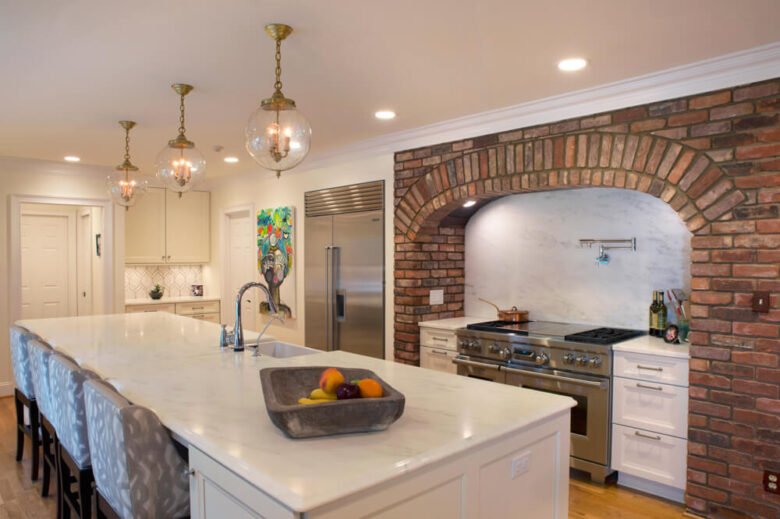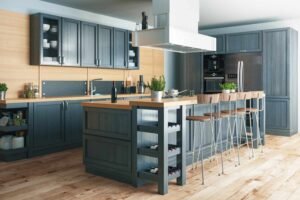When I go into a house to assess it, I like to start in the kitchen. Viewing the devices here may take some time. A redesigned kitchen can increase the value of your property, but you should consider what has to be done first.
Inspectors will look for built-in appliances such as ovens, cookers, dishwashers, waste compactors, extractor hoods, and anything else that is attached to a cabinet. This indicates that refrigerators are not covered by the inspection. To test any equipment, use it under typical conditions to see if it functions as planned. If the gadget requires the use of a button or other form of label, the label must be easy to read. No portion should be broken or fall off.
Stoves/Ovens/Hobs:
Labels indicating that the knobs have been abused while being cleaned; Since most people don’t utilize all of their burners, faulty burners are frequently left unfixed, necessitating your inspection of every burner. Use an oven thermometer to check the temperature when the oven is set to 350F (leave it on for at least 15 minutes; the temperature should be within 25 degrees of the set temperature); ovens act quite differently; verify that the oven’s light is on; the stove’s back wall To prevent it from toppling over, some sort of plate is required; Keep an eye out for rust, broken parts, or worn seals.
Dishwasher:
Run the regular cycle in the dishwasher to check for leaks (unused dishwashers have weaker seals); before you begin, place the arm in a recognizable position, and once you are finished, look for movement; offload more detergent to check if the wing door is open; Keep an eye out for rust, broken parts, or worn seals. NOTE: A switch, similar to a light switch, may be located on the rear wall of some dishwashers and must be switched on for operation.
Microwave:
To test whether it works, heat a cup of water; look for lights; Keep an eye out for rust, broken parts, or worn seals.
Disposer:
Run with water and watch out for loud noises and vibrations; If the appliance is leaking, check underneath the sink.
Extractor hood:
Run it at all speed settings while checking the filter for excessive vibration and noise; A few things to look at include the illumination, whether the ventilation duct is installed correctly (if there is any), and whether tape can be used to fix any mismatched pieces. Look for rusted and damaged components.
Refrigerator:
Examine the seals’ condition, then examine the batteries’ condition at the back. check to see if the unit is sufficiently chilled (some models’ “cold 1-2-3-4-5” temperature indicators make it difficult to determine whether the freezer or refrigerator is at or below 40 degrees Fahrenheit).
Sink:
Check the cold water handle as well as running hot water to see whether it flows through. Each container should be filled and drained to check for leaks underneath. Before the water enters the drain pipe, examine to see whether there is a siphon.
CAUTION: When There is probably a water leak if you see a pail under the siphon and leave a sponge there to clean, but look out for water stains inside the cabin.
Lights and outlets:
Countertop outlets must be GFCI (ground fault circuit interrupter), however outlets for appliances, particularly refrigerators, must not be GFCI. Additionally, countertop lights must be functional and have a cover so that glass doesn’t fall onto your food in the event of a power outage.
Trash Compactor:
Trash compactor should operate properly with a bundle of newspapers inside and have no broken parts or excessive noise or vibration.
Cabinets:
Hardware must be functional and in good working order; doors and drawers must be easy to open and close. Cabinet compartment materials must be tight and free of dents and dents. Cabinets must be attached to the wall.
Before taking out cabinets, keep the following in mind:
- Cabinets can get a fresh look by having the surface refinished (painting or staining).
- Replace the handles and hinges. This may quickly revitalize a kitchen.
- Think about changing the doors. This might be a simple and affordable fix if they are damaged but the cabinet frames are still in good condition.
- New countertops. Most home improvement stores can produce it and send it to you. This, along with new hardware, can drastically improve your kitchen’s appearance.
- Modern appliances. You can select a unit that fits your present area because many sizes are standard, which means you might not need to install new equipment for everything.
- New installation. While installing new fittings for lamps or faucets is typically simple, replacing faucets can occasionally be challenging. It is simple to install anything, including an earth leakage circuit breaker. Simply remember to exercise proper caution when working on fixtures by shutting off the water and electricity. This can be aided with a decent guidebook.
Conclusion:
The kitchen should always be the first room to be evaluated when evaluating a home because of its importance and potential to affect the property’s value. Built-in appliances including ovens, stoves, dishwashers, trash compactors, and extractor hoods are carefully inspected. It’s vital to remember that inspections often do not cover refrigerators.
Kitchen sinks, lighting, outlets, garbage compactors, and cabinetry are other crucial elements. Checking for leaks and adequate drainage, making sure outlets comply with GFCI regulations, and inspecting the state of cabinets, including their hardware, doors, and compartment materials, are all crucial.
Homeowners can increase the value, functionality, and appeal of their kitchen by following these recommendations and taking into account essential changes, thereby enhancing the overall appeal and marketability of their residence.
FAQs
1. Do refrigerators count as part of the kitchen inspection?
A typical inspection typically does not include refrigerators. Inspectors primarily concentrate on built-in appliances such extractor hoods, ovens, stoves, dishwashers, and waste compactors.
2. What exactly do I need to check out when I examine a dishwasher?
Run a routine cycle through the dishwasher while inspecting it to look for leaks. Before beginning, make sure the arm is in a recognizable posture; after the cycle is over, look for movement. Additionally, make sure the detergent is distributed properly. Check for any signs of rust, broken components, or worn seals.
3. How can I check an oven’s temperature accuracy?
You can use an oven thermometer to check the accuracy of an oven’s temperature reading. Turn on the oven to 350 degrees Fahrenheit and let it run for at least 15 minutes. Within 25 degrees of the predetermined temperature, the oven’s internal temperature should be.



